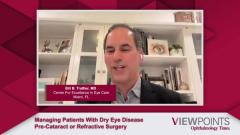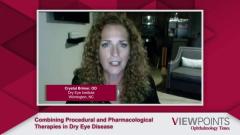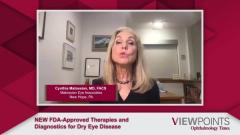
Co-Management of Dry Eye Disease
Experts discuss their clinical approaches for co-managing patients with dry eye disease and how they educate patients and their providers about the disease.
Episodes in this series

Transcript
Bill B. Trattler, MD: I'm going to jump to this next challenge that we face. We're going to have these new medications, and we have our current medications.And I'm going to start with Dr. Matossian on this one. We're here a mix of, the four of us are a mix of MDs and ODs, but we think alike in many ways in the way we manage the eye.Yet, there might still be some challenges when your patients are from different practices. For example, within my practice, I have a little different way of managing dry eye than I do when I'm outside of the practice. I want you to share your thoughts on some of the challenges when you're managing patients that have dry eye that are not in your practice, but maybe co-managing with another doctor nearby because you're sharing a patient for some reason.
Cynthia Matossian, MD, FACS: There can be challenges, but I think they're very much [able to be overcome].And the reason is, if we keep the patient in mind and if the patient remains the center focus of what we are all trying to do, we create a network of collaborative care, whether MD, OD, perhaps there will be other physician extenders coming into ophthalmology as there have been in other fields of medicine, such as PAs and physician’s assistants and so forth. Our goal is to provide the best care possible. It's through education, through local forms, virtual forms like this one, that everybody can collectively do the best they can to help patients who are suffering so much.
Bill B. Trattler, MD: I love that. And that's a great way, because I agree we need to be patient-centric. Dr. Brimer, any thoughts? Again, I know you're more of a referral practice, so I assume patients are getting sent to you, and you will send them back at some point. How important is communication? What challenges do you face when working with other practices, doctors outside of practices, MDs, or ODs?
Crystal Brimer, OD: My biggest challenge is in a timely referral, because then, when they get to me, they're frustrated that the person didn't send them sooner. And I have to manage that and smooth that over. But I've tried to assist this communication process: we made a marketing kit, and I made a three-minute video of everything we do- here's the problem, here's what we do. And my staff went around with it and showed them our investment in this space, [saying] “Here's everything we've purchased, we've got all the bells and whistles, we could take care of this patient, here's the report you'll get back.And then I made these prescription pads, and the top page says, tell me what you want me to do. Check the box. Everything you want me to do. Is it a dry eye of eval? Is it just a treatment? And then the bottom says, when do you want them back? And is it just with the report? Is it after the treatment's completed?
Is it for non-ocular surface disease symptoms? Once they're just for routine care. And then that page gets faxed to me. The second page gets handed to the patient, telling them what to expect. But here's what this did. It created a safe place where I am there to serve them. And just like if they sent somebody to you for cataract surgery, they're the gatekeeper. They are in charge of this patient and their ultimate care. And I don't want any part of that. I want to do this. And I want to serve you, the doctor, by helping your patient get better. But you are the one in charge. And when I did that, instead of going and asking for referrals and touting my skill or expertise, I don't say a word about that ever. There's not even anything in there about me. It's all about my investment into this and into my patients and them as referring physicians. And I want to get them better. My packet also talks about, meibomian gland loss and screening for it. It's not about competing for these patients. There are plenty to go around.
And it's about identifying when they need elevated care and what's best for them. Just like you said, Cynthia.
Bill B. Trattler, MD: That was a great overview. I think you're helping educate your local community both MDs and ODs, on how to work together and how to send the right patients in early. Dr. Nichols, you're at a teaching institution. Is that a big part of the curriculum? Identify dry eye early? And how are you trying to educate your students to make sure that dry eye is a top priority, even if they don't want to do the treatment?
Kelly K. Nichols, OD, MPH, PhD: I will say that one of the biggest challenges for optometrists is a bit of the misconception of the public. Patients will come in for a vision exam with vision insurance. And that only gives you a very specific exam that doesn't cover the medical part of dry eye. And patients expect to be very well treated. They want everything taken care of within that context. We often sell ourselves short in many instances. And this is where you actually have to be able to tell your patient that they need to come back and have a more thorough dry examination because you think that they have this condition, it needs to be better managed, and you can't do it within the context of that short vision exam. That actually is a barrier or a problem because patients will come into our clinic, they have vision insurance, and they want their exam, and they want everything taken care of.
We fight that as optometrists in terms of the medical versus the vision exam.After that, teaching students to see dry eye early is important. And again, it also gets messed up in the same issues that specialty clinics have in that students are learning how to do their exams, they're looking at retina, they're doing all these things. They may not be thinking about dry eye as much either. It's like prime grounds for teaching them that dry is everywhere you need to manage it. But we also refer to a dry-only practice because sometimes going to a practice like that is intriguing and positive for patients and they want to go somewhere to have that specific need taken care of that's different from a teaching clinic. And we don't have any problem in referring to that clinic. It all boils down to trust. If people who you're getting referrals from and who you're referring to know what each of you can do and know what's your lane and where the lanes overlap and having that communication, I think is an important thing to teach students. Go meet with these doctors or email or Zoom, so that you can let them know your services or have a packet like we heard about so that they can see what your services are. That creates that trust so that you have what's best for the patient in mind.And if you do that, you won't go wrong, as Cynthia mentioned.
Bill B. Trattler, MD: That is such a great comment because I like to know who the doctors are that have different areas of expertise and who has different devices for the treatment of dry eye in my community.Because we sometimes need to send patients out for various reasons. You don't want to send a patient that has a certain condition that that doctor doesn't love taking care. I try to find doctors in my area that love taking care of certain types of patients. So, you described having someone like Dr. Brimer who is passionate about identifying and treating and making patients happy with their condition which is just so wonderful. Dr. Matossian, I know in your community, you founded your institute, and you built a huge practice. What were some of the biggest challenges in working with the community of both MDs and ODs in your practice and in your community?
Cynthia Matossian, MD, FACS: I think communication is so important because when I started to do dry eye, which seems like eons ago when it was not as well known, people didn't talk about it, was something that people were not very familiar with. It took me a while to educate my colleagues about what I was doing and assure them that these patients are coming back to you because nobody wants to lose them. Assuring them that I will treat them, I will send them back when you want me to, or I will chronically take care of them until they develop a disease entity that you treat.
And by showing that we had a huge array of different treatment modalities, in-office, procedures, at-home remedies, and videos that we shared with our patients, it took the burden off of them and helped the patients. This way, they could concentrate on their love, which may be cataract surgery, or LASIK, or glaucoma, and give me the things that they were less passionate about doing. It's creating that trust, that communication, and that community to help the patient.
Bill B. Trattler, MD: Thank you. All of you have this great outlook on how to care for patients with dry eye, and how to work with the other doctors in the community. This is so exciting that we have such a breath of expertise here because even though I feel like I'm knowledgeable about dry eye, I learned so much and took away so many pearls from all of you.
Transcript is AI-generated and edited for clarity and readability.
Newsletter
Don’t miss out—get Ophthalmology Times updates on the latest clinical advancements and expert interviews, straight to your inbox.



























































